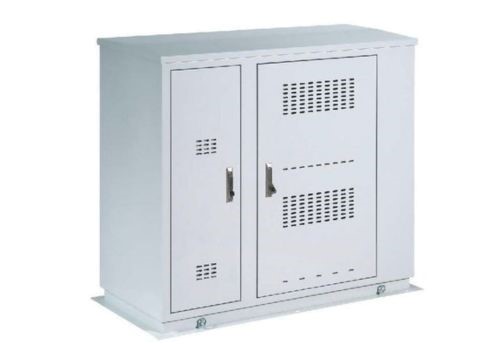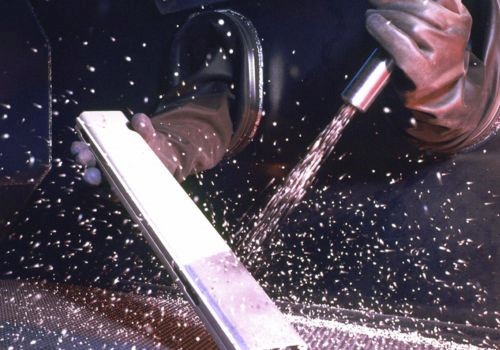Removing powder coats from electrical closures is easy when you know the steps to use. This article will cover what powder coating is and its different coat removal methods.
So, if you are planning to remove powder coating from your electrical enclosure, then read this guide:
What is Powder Coating?
Powder coating is used to finish different metal surfaces. They make these metal electrical enclosure surfaces attractive, durable, and effective.

Tools for Removing Powder Coat on Electrical Enclosures
Where tools and materials are concerned, the safety equipment required cuts across. Therefore, the safety equipment you will need includes:
- Protective gloves
- Protective clothing
- Safety goggles
- Respirator mask (if you will use chemicals or the method you choose will produce some dust)
Tools you need for Stripping Powder Coating on Electrical Cabinets
For each stripping method, there are some unique materials and tools needed for a successful striping process.
Let’s look at some common tools you can use to strip powder coated electrical enclosures:
Mechanical Stripping
- Wire brush or an abrasive pad
- Glass beads or aluminum
- Power sander with coarse grit sandpaper
- Sandblasting or bead blasting tools
Chemical Stripping
- Plastic scraper
- Brushes to apply
- Industrial paint stripper (ideal for powder coats)
- Metal container to keep waste
Thermal Stripping
- Heat gun
- Scrapper
- Oven
Blasting
- Water
- Media
- Blast tank
- Rust inhibitor
Thermochemical Stripping
- Water
- Stripping chemical
Other Alternative Options of Stripping
- Paint removers ideally made for powder coatings
- Solvent-based strippers
Techniques for Removing Powder Coat on Electrical Enclosure

1. Mechanical Stripping
For the mechanical stripping method, there is dust. Therefore, you need to wear your respirator or dust mask. Under this method, you can blast or scrape.
· Sandblasting
Under mechanical stripping using sandblasting, the ideal media to use include aluminum oxide or glass beads. You will use the media to blast and take the powder coating away.
You need to maintain a consistent distance as well as motion to prevent the substrate from getting damaged.
· Sanding
If you will be using a powder sander, begin with a coarse grit type to get rid of more of the coating.After the coarse grit is used, you can use the smoother grit to create the surface.
· Wire Brushing
Here, a wire brush is needed for areas that have small or detailed parts. Brush very hard to get rid of the coating.
2. Chemical Stripping
Chemical cleaning or stripping is one of the quickest ways to remove powder coating on electrical enclosure. Also, it is not expensive.
With this method, you can choose to dip electrical enclosure parts in a tank with chemicals in it or use a brush to apply the chemicals mostly to smaller parts.
This stripping technique can be achieved in two ways: hot and cold.
Hot Chemical Stripping
The chemicals in the tank are heated to 80 °C. This softens, dissolves, swells the coat, and finally falls off.
Cold Chemical Stripping
With cold chemical stripping, a solvent-based chemical stripper is mostly used. Here, you can either have parts dipped in a tank or use a brush to have solvent applied.
Advantages of this method:
- Easy process
- Both hot and cold methods are effective
- Cheaper to go through with
- Much tools not needed to achieve this stripping technique
Limitations of this technique:
- Can stain your skin
- Its harsh chemicals can affect your eyes if the right protective gear is not on.
- Chemicals not environmentally friendly
3. Thermal Stripping
Thermal stripping methods are achieved through three unique processes. They include the burn off, fluidized bed, and bake off stripping.
During the process of stripping electrical enclosure powder coated surface, heat is used to break down the powder coating. Usually, the powder coating on electrical enclosure turns it into ashes. In some instances, these ashes need to be removed.
Nonetheless, the substrate needs to resist the higher temperatures needed to break the coat down. Below are more details:
· Burn Off
Here, you will need temperatures ranging from 550 to 650 °C to have the coating ignited and made to burn. This is the quickest of all the thermal stripping methods. Ensure the ash is removed with water.
· Bake Off
With this technique, all parts are oven baked at 340 to 400 °C temperatures to ignite coating. Most of these ovens are designed with water-misting features to increase the rate of burning and keep the parts safe.
You need to wash all the ash after the burning process is done.
4. Fluidized Bed Stripping
With this method, inert media like oxides and sand are ideal for heat transfer. Fluidization takes place in sand and oxides due to heat, gas, or pressure from the air. The process for this is simple:
Step 1 – Hot medium at 425 °C is made available in a tank
Step 2 – All parts to be stripped are immersed into the medium in the tank.
Step 3 – You will need to leave it in the tank for 10 minutes. Here, the medium breaks the coating down. Then oxides and abrasive sand get rid of the ash.
You will not have to clean or wash electrical enclosure parts after taking them out. Some advantages of this technique include:
- Quick to use and see results
- Highly effective
- Easy to go through it
Some disadvantages
- Not all parts can come out of this process in their right state.
- Expensive method
5. Blasting to Remove Powder on Electrical Enclosure
When it comes to removing powder coating on electrical enclosure through this process, you can follow this simple process:
- Blasting has to do with removing powder coating by propelling abrasive materials onto the surface at higher speeds. Knowing these details is important:
- When material propelling is done by air, dry abrasive blasting is the result.
- When propelling is done by water, it is known as a wet abrasive blast.
- A blast that is aggressive will instantly get rid of the powder coating. However, it can damage the substrate. This makes it rough.
- Although gentle blasts take a longer time, it preserve the surface profile.
- Based on the part size and coating thickness that have to be removed, a sandblast room or cabinet is where dry abrasive blasting is done.
Some of the main advantages of blasting techniques include:
- You get to decide the blasting method to choose
- Quick to finish on smaller parts
- Wet blasting comes with no issues of major dust
- Wet blasting is cheaper compared to dry blasting
On the other hand, this process also has some limitations such as:
- For bigger parts it doesn’t finish quickly
- Leaves a huge surface profile on substrates
- It is difficult to prevent some damages on part surface
- Blasting tools are expensive, especially for dry blasting
- Dry blasting generates a lot of dust
- Right masks if not used can lead to health problems from dry blasting dust
6. Thermochemical Stripping
Thermochemical stripping techniques make use of temperatures ranging from 425 to 485 °C and chemical changes for coating removal on electrical enclosure.
This technique is ideal for inline and batch processes, both with minimal cycle time. Water is used to wash away residues and chemicals left as a result of coatings being stripped off. Residues and chemicals left as a result of coating stripped off.
Some important details to note down:
- This method can be used to remove powder coatings from parts with spots that are inaccessible or cannot take higher temperatures.
- Thermochemical stripping is the merging of thermal and chemical stripping. This makes it beneficial in many ways.
- Its combination means it doesn’t damage the substrate of the part.
Conclusion
Knowing how to use the right stripping methods to remove powder coating from electrical enclosures is important. You, however, get to decide what works for you after reading these details.
In case you want to remove powder coating from our electrical enclosure, we can handle it in our factory. At the same time, we can advise you how to remove powder coating from your enclosures now – contact us now for free inquiries.
More resources:
Mastering Powder Coating on Metal Techniques – Source: KDM
Advantages and Applications of Powder Coated Brass Parts – Source: KDM
A Comprehensive Guide to Brass Powder Coating – Source: KDM
Aluminum Powder Coating – Source: KDM
Electrical Enclosure Manufacturing Process in 7 Steps – Source: KDM
Guide to Electrical Enclosure Materials – Source: KDM




